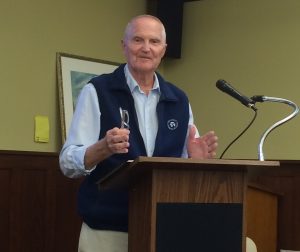On August 23, local historian Seth Mendell gave the second of five lectures in his series on the “Great War” – World War I. The lectures are a joint venture between the Mattapoisett Public Library and the Mattapoisett Historical Society Museum.
As he adjusted the microphone in the library’s meeting room, Mendell said with a sly smile, “I’m used to speaking to teenagers whose hearing is good.” The nearly full-to-capacity room responded with groans and chuckles. “As I have aged, so has my audience,” he responded. Mendell is a retired educator who taught for many years at Avon Old Farms School in Connecticut.
In his first lecture, Mendell laid the groundwork for the war that quickly found all of Europe rallying allegiances and arming soldiers from England to Russia. The assassination of Archduke Ferdinand and his wife Sophie on June 28, 1914 in Sarajevo is the well-known tipping point. What Mendell adds to the names, dates, and places is a deeper insight into the why of it all.
After the duke’s murder, countries throughout Europe grouped into two alliances – the Central Powers comprised of Germany, Austria-Hungry, and Turkey against the Allies comprised of France, Russia, Italy, Belgium, Serbia, Montenegro, and Japan. It wasn’t until 1917 that the United States entered.
The back-story goes like this: Serbia wanted to gain control of Austria-Hungry. The head of military intelligence for Serbia, Colonel Dragutin Dimitrijevic, deployed Gavrilo Princip to do the deadly deed of assassinating Ferdinand and his wife as they toured the region. Although warned of the impending assault by an insider, Ferdinand either did not believe it would happen or completely misunderstood the magnitude of the missive he received. Either way, he and she were cruelly dispatched.
This act, Mendell pointed out, was what caused a “tumble” into war.
Then Austria attacked Russia in a plan to free ‘slavs.’ Germany, who was tied to Austria, then came into the conflict against Russia. Because France had a treaty with Russia, they were drawn in and then came England. “It was a house of cards,” Mendell said, “It was a war that no one had expected.”
On the Eastern Front, Germany planned to attack France in a “sweeping” military maneuver that, unfortunately for them, failed. “The officers couldn’t communicate with one another…” across a vast 400-mile long front, Mendell explained.
Germany made other critical errors. They believed Belgium would stay neutral. They did not. They believed they could keep England out of France. They could not. And thinking the Western Front needed more troops than the Eastern Front, Germany repositioned nearly a half million soldiers to Russia.
Mendell also explained that during this time, military equipment evolved as a direct result of a new type of warfare: trench warfare.
The machine gun used by both sides was able to fire repeatedly at the top of the trench affording maximum protection to the soldiers operating it from the depths. And then there were the dirty weapons.
Germany used poison gas that floated across the militarized zone of the Eastern Front seeping into the trenches. Although the allied forces had gas masks, “They didn’t know when they were supposed to put them on,” Mendell said. It was the fleeing rodents that flooded into the waste-filled troughs that sounded the alarm that gas was on the way. There, in those reeking trenches, man and animal alike sought to survive. Adding to the ‘evil’ weaponry of the Germans was the flame-thrower.
Mendell added an aside to his commentary that gave WWI local context. He said that the Acushnet Rubber Company business “really got going” because it was making gas masks.
As the war dragged on, Germany’s use of submarines would, in part, draw the United States into the theater of war.
The sinking of the Lusitania, Mendell stated, was not the prime reason the U.S. entered the war, but it did contribute to President Wilson finally breaking all ties with Germany and joining the allies in 1917.
Regarding the Lusitania, Mendell had one more anecdotal story to share. Avon Old Farms had been designed by one of the survivors – Theodate Pope Riddle, the first female architect in Connecticut to receive a license in this primarily all-male profession.
Mendell read from Riddle’s letter to her mother describing the horrors she witnessed as she floated among the ship’s debris along with the living and the dead. As Mendell read her words, the audience was transfixed.
Although everyone knows how this chapter in history ends, Mendell’s re-telling and ability to weave the seemingly disparate details into a cohesive story is more than educational, it’s entertaining.
Subsequent lectures will be held in the Mattapoisett Library’s meeting room at 7:00 pm on September 6, United States Entry and the finale on September 13, Ploughboys and Doughboys. The third lecture on The Middle Phases was held on August 30.
Mendell will also give a lecture – sponsored by the Mattapoisett Historical Museum – on September 4 in Shipyard Park on the history of Naushon Island.
By Marilou Newell
